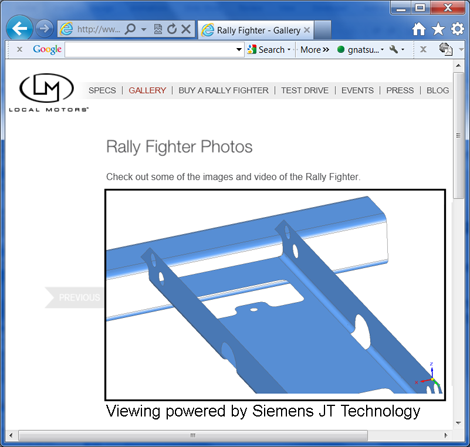
If you’ve been following the outstanding work Stephen has been doing on the blog, you’ll have read earlier last week about how Siemens PLM has teamed up with the current ‘Engineering Company du Jour’ Local Motors to help its crowdsourcing projects to develop new vehicles.
Well now those details have become more clear – a few hours earlier than was planned, following Mr Mings getting it up and online first.
For those that aren’t familiar with the concept, crowdsourcing is defined as “the act of sourcing tasks traditionally performed by specific individuals to a group of people or community (crowd) through an open call.” (thanks Wikipedia and Erin at PTC who has a well thought out post on the whole subject).
There’s a tonne of crowdsourcing organisations out there, from my own personal favourite of Threadless (threadless.com) for t-shirts, into the realms of product design with Quirky and GrabCAD.
In the case of Local Motors, the focus of the projects is to develop new sub-systems or indeed, new vehicle concepts in a manner entirely different to the traditionally highly secretive and closed automotive world. As our very own Stephen put it recently, “
Using a method described as ‘co-creation’, it lets them work in a way completely different to other automotive companies, allowing them to uncover better ideas faster with new and interesting material and power-train ideas as soon as they are available.” And if you don’t believe Stephen, maybe this guy will be more convincing?
So what has Siemens PLM cooked up with the Local Motors team? The answer is on two fronts.
Firstly, it’s been announced that the JT format will become the preferred method of sharing 3D data amongst the community. No matter what format you upload 3D design and engineering data, a server side solution will convert it into JT and present it using the lightweight format for collaboration and visualisation. In addition, a new service will allow Local Motors community member to download the data for reuse (where applicable and allowed) in either IGES or Solid Edge format. The latter should give you a clue as to the second part of the announcement

Local Motors will be integrating JT visualisation technology into its community sites as standard.
Local Motors x Solid Edge Design1
This is fascinating. From today onwards, a custom version of Solid Edge will become the preferred (or recommended rather) system for working within the Local Motors community. Essentially, this is the Synchronous Technology portion of Edge in a separate package. All of the part modelling will be present along with basic assembly modelling (think: constraints, mass properties).
Data translation tools are available to read in the usual IGES and STEP data, but also Pro/Engineer and SolidWorks and a few others. It will also allow you to output to pretty much the same formats. It’s also worth noting that this is about 3D data creation and as such, there are no drawing or draughting tools. It’s also worth noting that the native data from Solid Edge Design1 is NOT compatible with commercial licenses, so no thinking this is a cheap way of getting a new CAD system.
So how will this be delivered? Until January 1st, Local Motors community members will be able to download a 30 day trial for free. Then, once the kinks have been ironed out (those are my words, not Siemens’), the price will be $19.99 per month. It is worth noting that the trial will be by invitation only and community members can contact Local Motors immediately.
Thoughts?
Interesting move by Siemens PLM this one. Find a community, give it some tools and charge them a small monthly fee to get access to the tools they probably need. Will it work? Who knows and here’s why I have a few doubts.
The press release has the following statement:
“By offering professional CAD at an affordable price, Design1 establishes a new category of CAD software for design and engineering enthusiasts that fills the gap between free or low-cost solutions with limited functionality, and higher priced full-function commercial solutions.”
There’s one word that I find bothersome in this context. Enthusiasts. There’s an assumption that the people that are engaging and interacting with the Local Motors projects are just somehow cut from a different cloth than Siemens PLM’s usual ‘professional’ customer base. Even the fact that its being flagged up in the press release shows the thought process.
Here’s the thing.
The people that engage with this type of thing aren’t enthusiasts. They’re designers and engineers. Period. Full Stop. End of story. Yes, some of them might not generate their main living from the act of designing and engineering, but that’s academic in this instance. These people are contributing to some advanced engineering projects such as electric vehicle development. Do they want a hacked about, cut down version of a ‘professional’ tool? Or do they want the proper thing?
Siemens PLM, like other software vendors in the engineering space, seem to have confused the need for a low-cost tool with a the need for a pretty crappy tool. the Local Motors version of Solid Edge sees some of the most powerful parts of Solid Edge stripped out, the remainder left and its sold cheap. I don’t have a problem with cheap, but I do wish engineering software vendors would realise that in today’s world, ‘low-cost software’ doesn’t automatically equate to ‘functionally restricted software’.
After all, if these enthusiasts are serious about the process, chances are they’ve either got student versions of a CAD tool, they’ve downloaded a torrent of SolidWorks or Catia or something else, or God forbid, they’ve bought Alibre. Dangling the carrot of Sync Tech Solid Edge for 20 bucks a month isn’t going to change that.
To my mind, a more intelligent approach would have been to provide all of Solid Edge’s tools, follow the same restrictions and pricing model and expose the 25,000 strong Local Motors community to what a professional system can really do.
A missed opportunity I suspect.
It also brings to mind the cloud. After all, a community like Local Motors exists on the internet (unless you shell out the cash for to build one of their Rally Fighters). As CAD systems move towards the cloud, this type of collaboration between the CAD vendor and the Community will become more common. Imagine something like GrabCAD or Local Motors having its own hosted version of various CAD applications? That’s when all things crowdsourcing and CAD will get more interesting.






